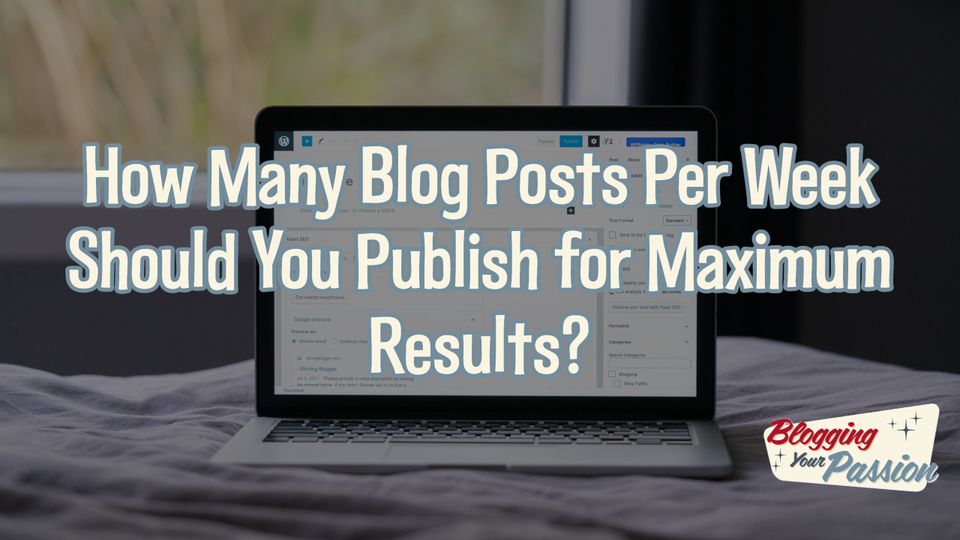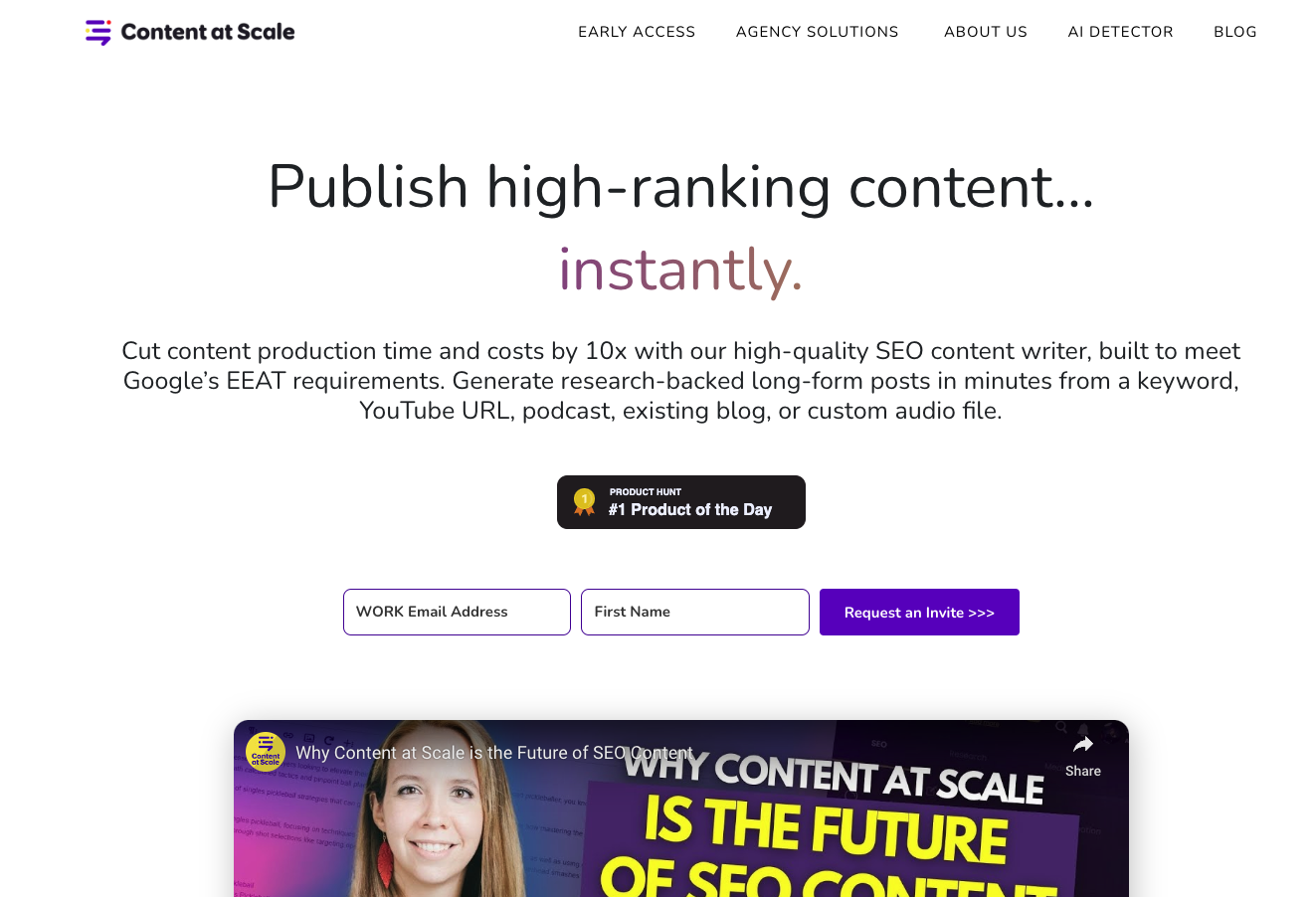How Many Blog Posts Per Week Should You Publish for Maximum Results?

Are you looking to maximize the results of your blog? Wondering how many blog posts per week you should publish?
We'll explore the benefits of publishing regularly, the ideal number of posts per week, and how to ensure each post is of the highest quality.
Get ready to take your blog to the next level with this essential guide!
Table of Contents (click to expand)
- How Many Blog Posts Per Week?
- The Benefits of Publishing Regularly
- How to Ensure Each Post is of High Quality
- Increased Traffic and Engagement
- Earn Money Blogging
- The Ideal Number of Posts Per Week
- Quality Over Quantity
- Start Slow and Increase Gradually
- Take Advantage of Automation
- Building Organic Traffic Takes Time
- How to Ensure Each Post is of the Highest Quality
- Plan Ahead and Create a Content Calendar
- Common FAQ's on How Many Blog Posts Per Week
- What is Google's Perspective on Newly Published Pages?
- How Long Does It Take for a Blog to Rank on Google?
- How Often Should I Publish New Blog Posts for SEO?
- How Often Should I Blog If I'm Just Starting?
- How Can I Blog Faster?
- Conclusion
How Many Blog Posts Per Week?
After you learn how to start a blog, the first big question is: How many blog posts should publish per week?
Maybe you are looking for the right balance between effort and results?
Maybe you want to know how many blog posts per week for ranking in Google?
Whatever your goal, we are going to break it all down for you in this step-by-step guide.
The Benefits of Publishing Regularly

Regularly publishing blog posts has many benefits. It helps to keep your readers engaged and encourages them to come back for more.
It also helps to build your reputation as an authoritative source of information in your field.
Regular publishing can help to boost your website's SEO rankings, as search engines prioritize websites with frequent content updates.
How to Ensure Each Post is of High Quality
To ensure each post is of the highest quality, it's important to take the time to plan and research each topic thoroughly.
Make sure to include relevant and up-to-date information, and double-check all facts before publishing.
Use engaging language and visuals to make your posts more interesting and appealing to readers.
Finally, once the post is published, take the time to promote it through social media and other channels.
Increased Traffic and Engagement

Having a consistent presence on social media can help you to build relationships with your audience, which can lead to increased sales.
When you post regularly, your followers will be more likely to remember your brand and will be more likely to engage with your posts.
A great example of this is Pinterest. The more often you blog, the greater chance you have of driving traffic from Pinterest. This is because readers will pin your post to their Pinterest account.
When you post consistently, it provides your followers with more opportunities to share your content, which can help you to reach a larger audience and increase your visibility.
Having a strong online presence can help you to boost your credibility, as it shows that you are a reliable source of information.
Earn Money Blogging
Another benefit to publishing regularly is that it will increase the revenue of your blog. There are many ways to make money with a blog, but more organic traffic supports all of them.
The Ideal Number of Posts Per Week
So, how many blog posts per week should you shoot for?
When it comes to the ideal number of blog posts per week, it depends on the size of your audience and the amount of time you have available to write.
For most bloggers, publishing at least one blog post per week is a good starting point.
However, if you have the resources and the time, you may want to consider publishing two to three posts per week.
This will help to keep your readers engaged and ensure that your website remains visible in search engine rankings.
If you have the resources, you may even want to consider publishing more than three posts per week.
Quality Over Quantity
No matter how many blog posts you decide to publish each week, it's important to remember that quality should always come first.
It's better to focus on creating fewer, high-quality posts than to rush out a large number of posts that lack substance.
It's important to be mindful of the topics you choose and to make sure they are relevant to your readers.
Remember to take the time to proofread and edit each post before publishing, to ensure that it is free of any errors. I use a service called Grammarly.com.
This will help to ensure that your readers have the best experience possible and will be more likely to return to your blog in the future.
When it comes to creating blog content, it is essential to consider your niche and audience.
Knowing who you are writing for and understanding their interests and preferences can help you craft content that resonates with them.
Also see: How to Write a Blog Post
Start Slow and Increase Gradually
When you first start blogging, it can be tempting to try and publish as much content as possible.
However, it's important to start slow and increase gradually. Content marketing is a fantastic way to get free targeted traffic to your site, but it is a time commitment.
Take Advantage of Automation

To make the process of creating content easier, it's a good idea to take advantage of automation tools.
Automation tools can help you to save time by scheduling posts in advance, as well as helping you to track your post performance.
This can be especially helpful if you are managing multiple social media accounts.
When it comes to creating high-quality content with AI, I've tried every tool out there.
There are two AI tools that stand out amongst the rest:
Building Organic Traffic Takes Time
It's important to be patient and consistent with blogging. Building an audience takes time, and it's important to stick to your posting schedule and continue to produce high-quality content.
With the right strategies, you can create a successful blog that engages and resonates with your readers.
How to Ensure Each Post is of the Highest Quality
When creating content, it is important to focus on quality over quantity.
Aim for at least one post per week, and ensure that each post is of the highest quality by taking the time to proofread and edit it.
Use visuals to break up text and make your content more engaging.
Visuals such as images, videos, and infographics can help to grab the attention of your readers and make your content more memorable.
Finally, use keywords and SEO techniques to make sure your content marketing is optimized for search engines.
Plan Ahead and Create a Content Calendar

To ensure that you remain consistent and organized, it's a good idea to plan ahead and create a posting schedule.
This will help you to keep track of the blog content you plan to cover, and the days you plan to publish.
A good content calendar helps to ensure that your posts are spaced out evenly and that your readers don't feel overwhelmed with too much content.
You can also use a blog posting schedule to brainstorm ideas and plan out your content marketing in advance.
This will help to ensure that you have a steady flow of ideas and that you don't run out of topics to write about.
Also, use analytics to help you measure the success of your content.
Analytics can give you valuable insight into which topics and types of quality content resonate with your readers and which topics are not.
This will help you to create more effective content in the future.
Research and Use Relevant Keywords

Researching and using relevant keywords is an important part of optimizing your content for search engines.
Using the right keywords can help you to reach a broader audience and increase your visibility.
Make sure to include keywords in your titles and headings, as this can help to make your quality content more visible.
Link to other relevant content within your posts to provide more value to your readers.
This will help to keep them engaged and will also help to improve your search engine rankings.
Write Compelling Headlines and Introductions
To make your content more appealing, it's important to write compelling headlines and introductions.
Your headline should be attention-grabbing and should accurately reflect the content of your post.
The blog introduction should be engaging and should provide a clear overview of the topic.
Use storytelling techniques to make your content more memorable.
Stories can help to create an emotional connection with your readers and can help to make your content more relatable.
This can be especially helpful if you are trying to promote a product or service.
Use Visuals to Enhance Your Content
Use visuals such as images and videos to make your content more engaging and eye-catching.
This can help to draw readers in and make them more likely to read your posts.
Make sure to also use hashtags to increase the visibility of your posts.
This can help to reach a larger audience and can also help to increase the engagement of your posts.
Edit and Proofread Thoroughly

Once your post is complete, it's important to take the time to edit and proofread it thoroughly.
Check for any typos, spelling errors, or grammar mistakes that could detract from your content.
Make sure to also check for any factual inaccuracies or outdated information that could lead to confusion.
Use readability tools to make your post easy to read. This will help to ensure that your readers can understand and absorb your content quickly and easily.
Use a plagiarism checker to make sure that your post is original and that you are not using any content without giving proper credit.
This will help to ensure that your post is of the highest quality.
Common FAQ's on How Many Blog Posts Per Week
What is Google's Perspective on Newly Published Pages?
When Google encounters newly published pages, it crawls and indexes them to include in its search results.
However, it's important to note that the exact timing and ranking of these pages can vary.
To increase visibility, optimize your new pages with relevant keywords, ensure proper site structure, and consider building high-quality backlinks.
Regularly monitoring your website's performance and leveraging Google Search Console can also help you understand how Google views and treats your newly published content.
How Long Does It Take for a Blog to Rank on Google?
The time it takes for a blog to rank on Google can vary significantly depending on several factors.
Generally, it can take anywhere from a few weeks to several months.
Factors that influence ranking speed include the competitiveness of the keyword, the quality and relevance of the content, the website's domain authority, and the effectiveness of your SEO efforts.
To improve your chances of ranking faster, focus on creating high-quality, keyword-optimized content, building quality backlinks, and consistently optimizing your website for SEO (search engine optimization).
Patience and persistence are key to achieving long-term success with Google rankings.
How Often Should I Publish New Blog Posts for SEO?
The frequency of publishing new blog posts for search engine optimization can vary depending on your specific goals and resources.
However, a general guideline is to aim for a consistent and regular posting frequency.
This could mean publishing new content once a week, twice a month, or even monthly, as long as it's consistent.
Quality should be prioritized over quantity, so focus on creating valuable and well-optimized posts that resonate with your target audience.
Also, the length of a blog post matters too. Find the average length of a blog post by searching your chosen keyword in Google. Then analyze the top pages and the number of words per page.
For more info see: How Long Should a Blog Post Be?
Finally, maintaining a consistent posting schedule can help search engines recognize your site as an authoritative source and improve your overall SEO performance.
How Often Should I Blog If I'm Just Starting?
If you're just starting a blog, it's recommended to set a realistic and manageable publishing frequency.
Starting with one blog post per week is a good approach to establishing consistency and developing a routine.
This allows you to focus on creating high-quality content while also giving you time to promote and optimize each post effectively.
As you become more comfortable and efficient, you can gradually increase the frequency if desired.
Remember, quality and relevance should always take precedence over quantity, especially in the early stages of your blog.
How Can I Blog Faster?
To blog faster and increase your productivity, here are a few tips:
1. Plan your content: Before you start writing, outline your blog post and gather all the necessary information and resources. This will help you stay focused and organized throughout the writing process.
2. Set a time limit: Allocate a specific amount of time for each blog post. This helps prevent overthinking and encourages you to work efficiently within a defined timeframe.
3. Minimize distractions: Find a quiet and comfortable workspace free from distractions like social media or excessive noise. Consider using productivity tools or website blockers to stay focused during writing sessions.
4. Write first, edit later: Avoid editing or proofreading while writing. Instead, focus on getting your ideas down on paper first. Once you have completed the initial draft, set aside dedicated time for editing and polishing your content.
5. Use templates or frameworks: Develop reusable templates or frameworks for your blog posts. This can include a standard structure, headings, and formatting guidelines, which saves time and streamlines your writing process.
6. Practice speed writing: Set a timer and challenge yourself to write as much as possible within a specific timeframe. This exercise can help improve your writing speed and train you to think and articulate ideas quickly.
7. Eliminate perfectionism: Remember that blogging is a continuous learning process. Don't aim for perfection in your first draft; focus on conveying your message effectively. You can always refine and improve your posts later.
8. Use Blog AI Writing Tools: While many AI writing tools are worthless, there is one that stands out above the rest. Check out ContentAtScale.ai and see why they are an industry leader at creating long-form blog content.
By implementing these strategies, you can boost your writing speed without compromising on the quality of your blog posts.
Conclusion
In conclusion, creating content for your blog or website can be a great way to reach a wider audience and engage with your readers.
It's important to use the right tools and techniques to ensure that your content is optimized for search engines, engaging, and original.
Use content calendars to plan out your posts, research and use relevant keywords, write compelling headlines and introductions, use visuals to enhance your content, and edit and proofread thoroughly.
Following these tips will help you to create content that is high-quality and engaging.
Regular blogging can be a great way to keep your website up to date and provide your readers with fresh content.
It can also help to increase your visibility on search engines and drive more organic traffic to your website.
Blogging can help to build relationships with your readers and establish yourself as an authority in your field.
By regularly creating content that is engaging and optimized for search engines, you can ensure that your readers have a positive experience and will keep coming back for more.
